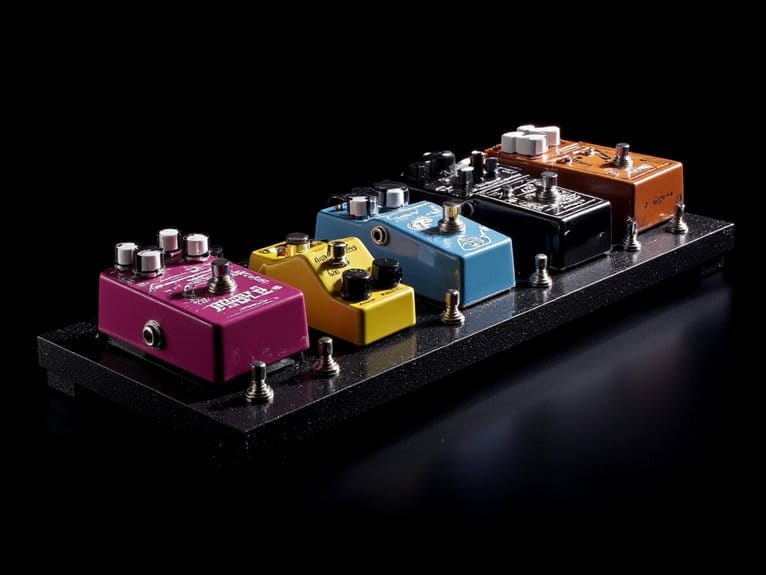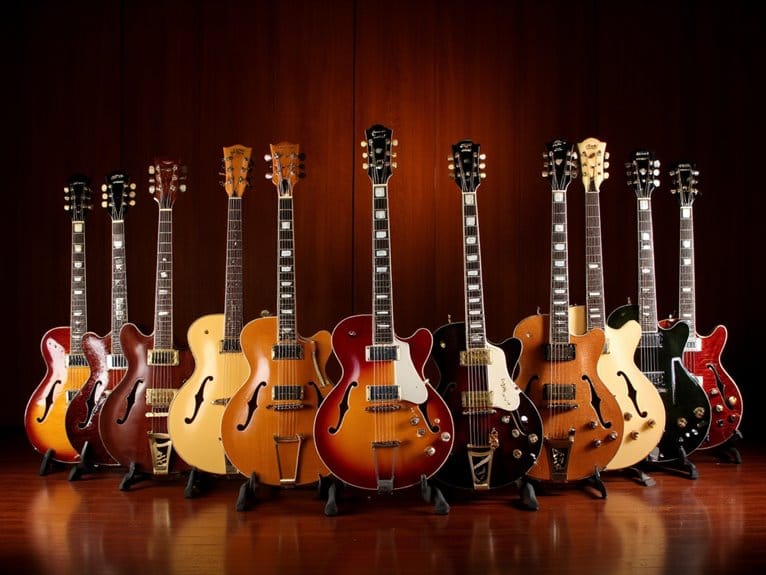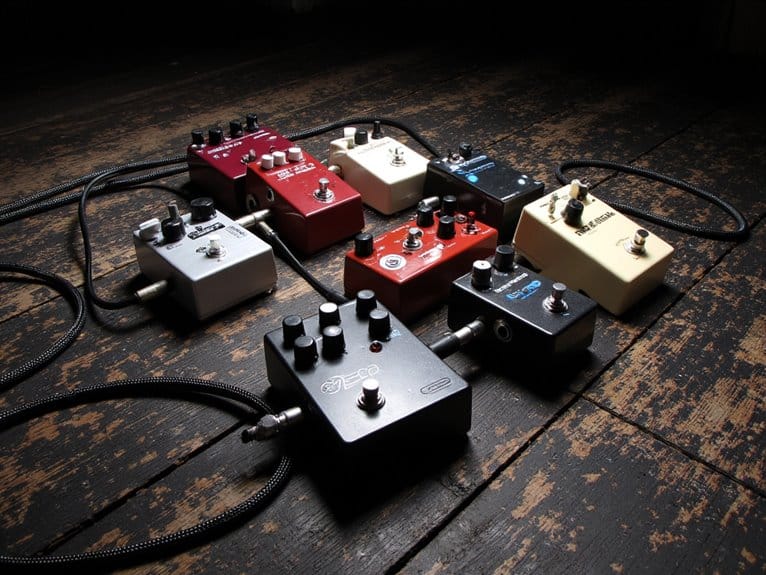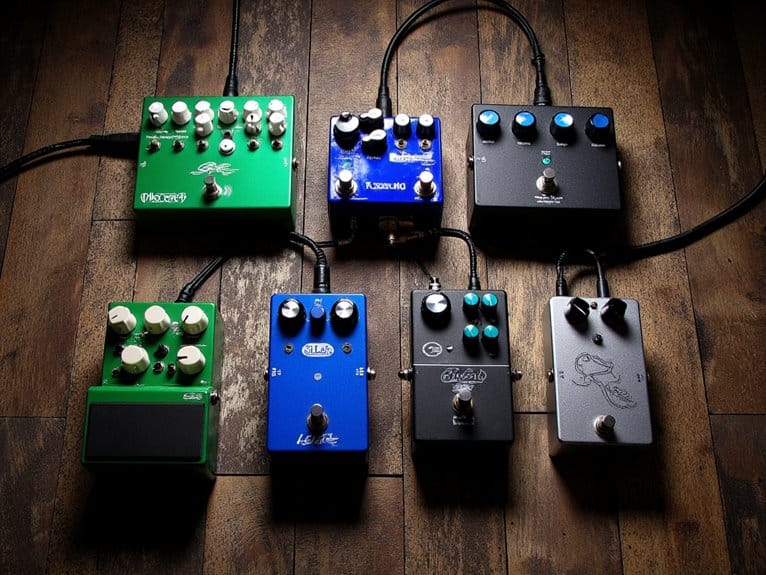10 Best Guitar Pedalboards – Organize Your Sound in Style
I’ve spent countless hours testing pedalboards, and the best options for 2025 balance power, portability, and organization. The LEKATO stands out with its integrated 9-port power supply, while STRICH boards offer excellent build quality and convenient carry bags. For smaller setups, the SPB-14’s angled design provides easy access to your effects, and the expandable DAddario XPND grows with your collection. Each board I’ve selected addresses specific needs, from beginner-friendly options to professional touring rigs that’ll transform your entire approach to effects management.
We are supported by our audience. When you purchase through links on our site, we may earn an affiliate commission, at no extra cost for you. Learn more.
Notable Insights
- LEKATO Guitar Pedal Board offers compact 19×5.1-inch design with integrated 9-port power supply for streamlined gigging setups.
- STRICH pedalboards provide lightweight aluminum construction with zippered storage pouches for enhanced portability during live performances.
- Size selection depends on pedal collection needs, with boards ranging from 3-4 pedal capacity to extensive multi-pedal configurations.
- Integrated power systems with multiple independent outputs eliminate cable clutter while ensuring compatibility with high-draw digital pedals.
- Aluminum alloy construction delivers optimal durability-to-weight ratio, while angled designs and cable management features improve accessibility and aesthetics.
LEKATO Guitar Pedal Board with Built-in Power Supply
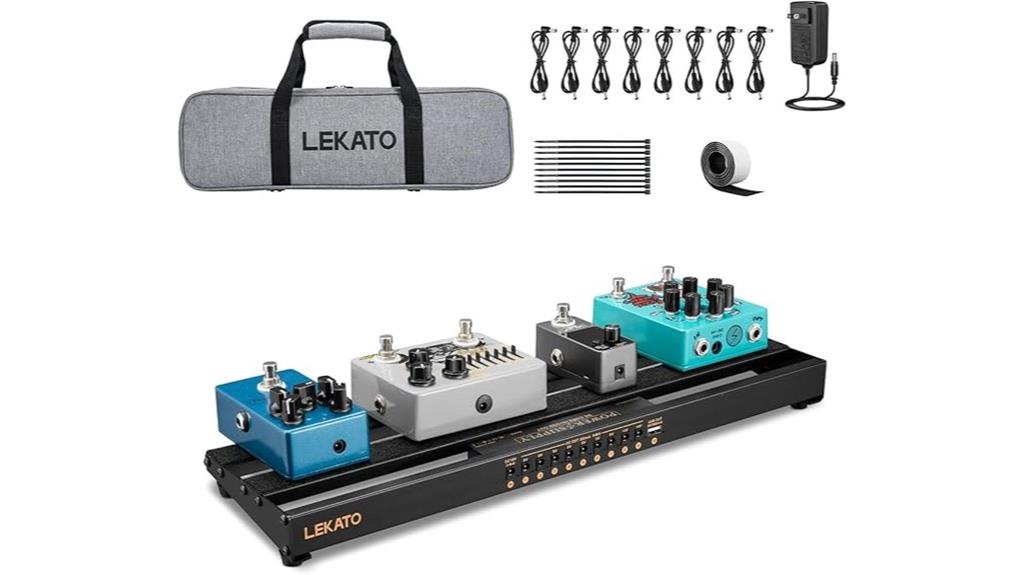
When you’re looking for a pedalboard that eliminates the hassle of separate power supplies and cable management, the LEKATO Guitar Pedal Board stands out as an all-in-one solution that I’ve found particularly appealing for gigging musicians who value efficiency over sprawling setups. This aluminum alloy board measures 19 x 5.1 inches, weighing just 1.8 pounds, and integrates nine independent power ports including 7×9V, 1×12V, 1×18V, plus a USB port for phone charging. The angled design prevents accidental pedal stomping, though some users report noise issues with the internal power supply that you’ll want to take into account.
Best For: Gigging musicians and guitarists who want a compact, lightweight pedalboard solution with integrated power supply to eliminate cable clutter and simplify their setup.
Pros:
- All-in-one design combines pedalboard and power supply with 9 independent ports (7×9V, 1×12V, 1×18V, plus USB) eliminating need for separate power units
- Lightweight aluminum alloy construction at just 1.8 pounds with angled design that prevents accidental pedal stomping
- Includes high-quality carrying bag and adhesive hookside tape, making it highly portable for gigging musicians
Cons:
- Some users report noise issues with the internal power supply that can affect audio quality
- Pre-attached velcro tape can be inconvenient for pedal placement and repositioning
- Limited patch cables included, requiring additional purchases to maximize usability
STRICH Guitar Pedal Board Aluminum Alloy Pedalboard with Carry Bag
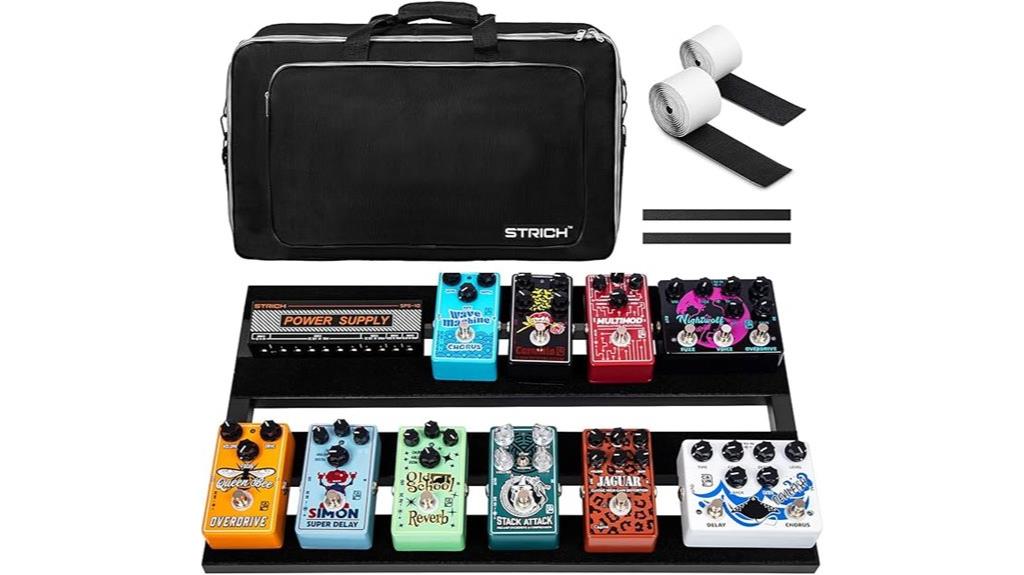
The STRICH Guitar Pedal Board’s aluminum alloy construction and included carry bag make it an exceptional choice for gigging musicians who need reliable transport without sacrificing organization. At 2.65 pounds with dimensions of 22 x 12.5 x 3.15 inches, you’ll appreciate how this pedalboard balances portability with functionality, though I’ve found the angled design particularly useful for quick pedal access during performances. The integrated zippered pouch provides convenient storage for cables and small accessories, while the included Velcro strips secure your effects reliably. With 4.7 stars from 345 customers and ranking #17 in its category, this board demonstrates consistent performance.
Best For: Gigging musicians who need a lightweight, portable pedalboard with reliable organization and transport capabilities for live performances.
Pros:
- Lightweight aluminum alloy construction at only 2.65 lbs makes it highly portable for gigs
- Includes rugged carrying case and integrated zippered pouch for comprehensive transport and storage
- Angled design provides comfortable pedal access during performances with secure Velcro mounting system
Cons:
- Some users report difficulties fitting power supplies properly
- Cable management can be challenging according to customer feedback
- Limited to MINI and STANDARD sizes which may not accommodate larger pedal collections
Guitar Pedal Board 14 x 10.6 with Carry Bag (SPB-14)
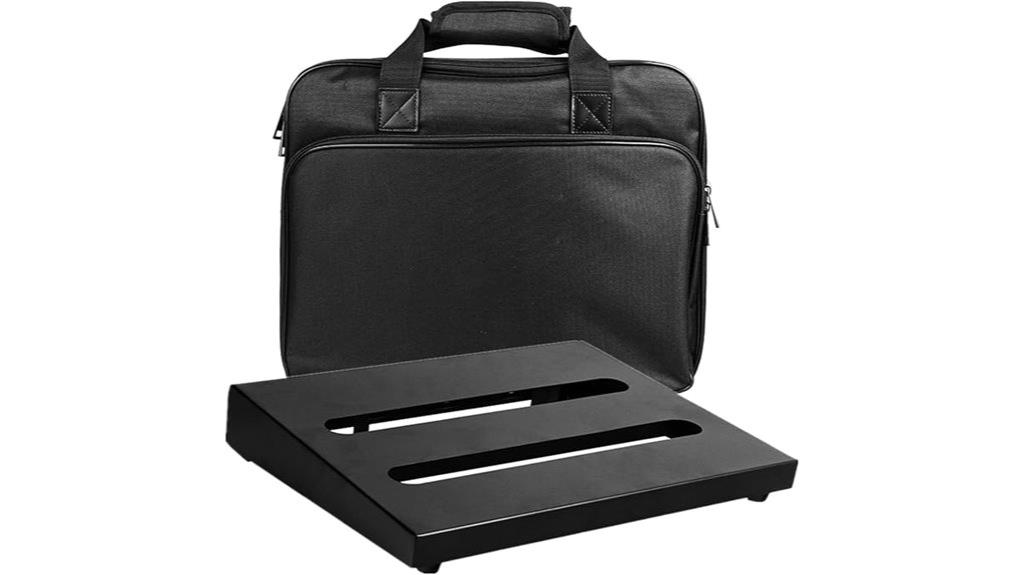
Musicians seeking a reliable, mid-sized pedalboard that won’t break their backs or budgets will find the Guitar Pedal Board 14 x 10.6 with Carry Bag (SPB-14) strikes an impressive balance between functionality and portability. At 2.98 pounds, this steel-constructed board accommodates 6-8 pedals comfortably, featuring an 8-degree angled design that improves pedal accessibility during performances. The included velcro strips secure your pedals effectively, while strategic cable management openings keep your setup organized. Though customers consistently rate it 4.6 out of 5 stars, some express concerns about the carry bag’s durability, suggesting you might need a replacement eventually for heavy touring use.
Best For: Musicians who need a portable, mid-sized pedalboard for 6-8 pedals that offers good value for home practice, gigging, or as a backup board without requiring a large investment.
Pros:
- Lightweight at 2.98 pounds with an 8-degree angled design that improves pedal accessibility during performances
- Strong steel construction with 1500-pound tensile strength and organized cable management openings
- Excellent value with high customer satisfaction (4.6/5 stars) and includes velcro strips for secure pedal attachment
Cons:
- Carry bag quality is questionable and may need replacement for heavy touring use
- Limited to smaller setups of 6-8 pedals, not suitable for larger pedalboard configurations
- Mixed feedback on carry bag durability suggests it may not withstand frequent transport
Medium Guitar Pedal Board with Cables and Carrying Bag
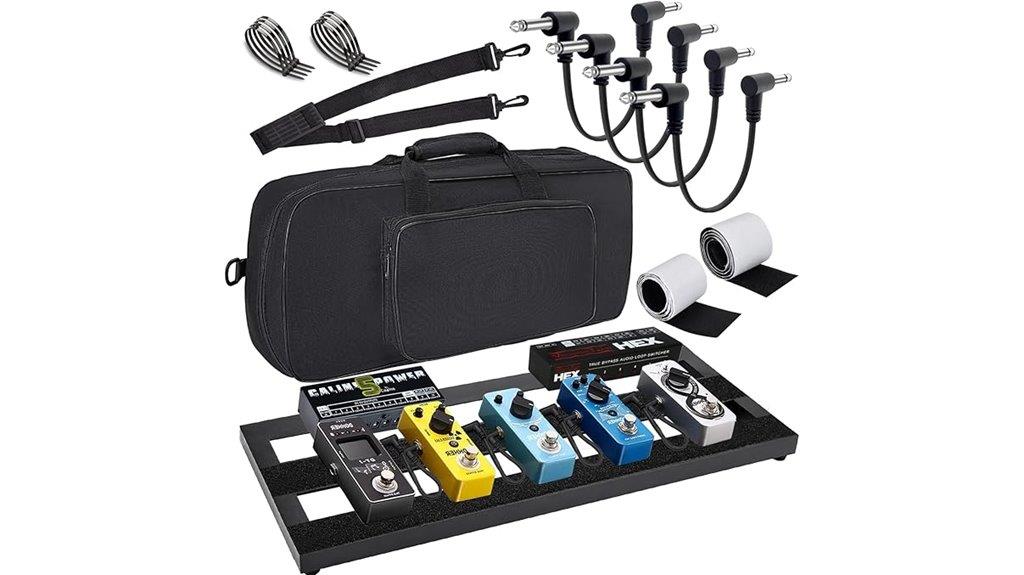
Compact setups demand efficient organization, and I’ve found that the GOGHOST Medium Guitar Pedal Board delivers exactly what minimalist players need with its thoughtful inclusion of cables, mounting hardware, and a protective carrying bag. This aluminum alloy board measures 20x8x1.2 inches, weighing just 3.14 pounds, making it surprisingly portable for gigging musicians who don’t want to lug around massive rigs. You’ll fit 4-5 standard pedals comfortably, depending on your configuration, while the included 6-inch cables, adhesive strips, and zip ties eliminate the guesswork of assembling your first pedalboard setup, though I’ve noticed the power supply clearance underneath remains somewhat limited for larger adapters.
Best For: Beginner to intermediate guitarists who need a portable, lightweight pedalboard solution for small setups with 4-5 pedals, particularly those who want a complete starter package with cables and carrying bag included.
Pros:
- Complete starter package includes everything needed: pedalboard, cables, mounting hardware, and waterproof carrying bag
- Lightweight aluminum construction (3.14 lbs) with rubber feet provides durability and stability while remaining highly portable
- Excellent value with thoughtful design features like cable routing channels and flexible mounting options for organized setups
Cons:
- Limited space underneath for larger power supply adapters, which may require external mounting
- Size constraints restrict it to 4-5 standard pedals maximum, making it unsuitable for larger pedalboard setups
- Lacks tilt functionality that some users desire for better pedal accessibility during performance
STRICH Guitar Pedal Board with Built-in Power Supply (PB-S15)
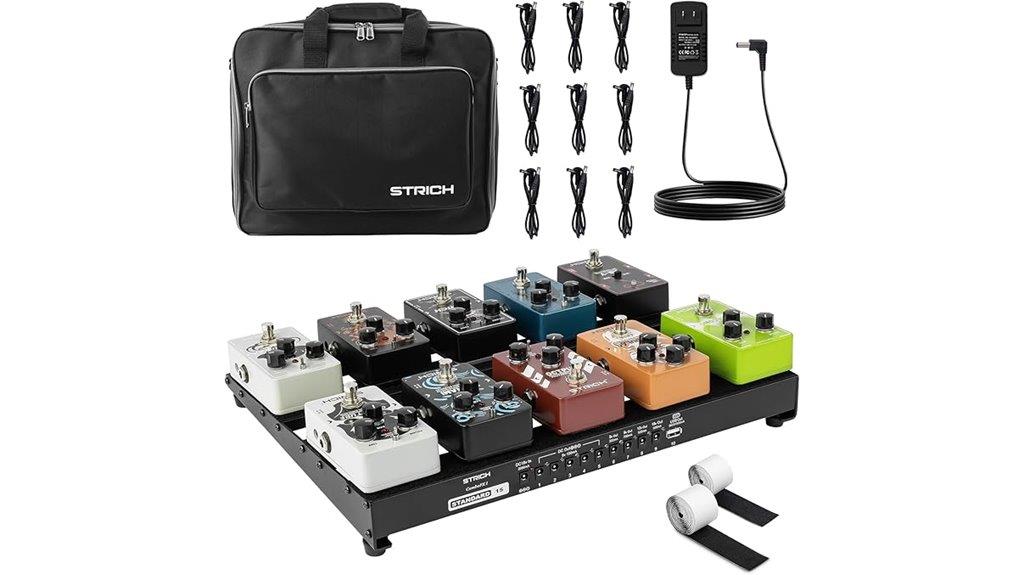
Power-hungry guitarists who’ve grown tired of daisy-chaining multiple wall adapters will find their salvation in the STRICH Guitar Pedal Board PB-S15, which combines a spacious 15 x 11-inch aluminum platform with an impressively robust built-in power supply that I’d argue rivals dedicated units costing twice as much. The ten independent ports include seven 9V outputs at varying amperages, plus 12V and 18V options, alongside a bonus USB charging port that’ll keep your phone alive during those marathon practice sessions. At 2.17 pounds, it’s surprisingly lightweight considering the power capabilities, and the ergonomic incline actually makes踏板switching more comfortable than I expected.
Best For: Guitarists who use multiple effects pedals and want to eliminate the hassle of daisy-chaining power adapters while maintaining a clean, organized setup.
Pros:
- Built-in power supply with 10 independent ports offering various voltage and amperage options (9V, 12V, 18V) plus USB charging capability
- Lightweight yet durable aluminum construction at only 2.17 lbs that resists bending and warping
- Includes comprehensive accessories like gig bag, power adapter, cables, and adhesive strips for complete setup
Cons:
- Display pedals are not included, requiring separate purchase of effects pedals
- Limited to 15 x 11-inch board size which may not accommodate larger pedal collections
- Four-row horizontal layout may not suit all pedal arrangement preferences
LEKATO Guitar Pedal Board with Built-in Power Supply
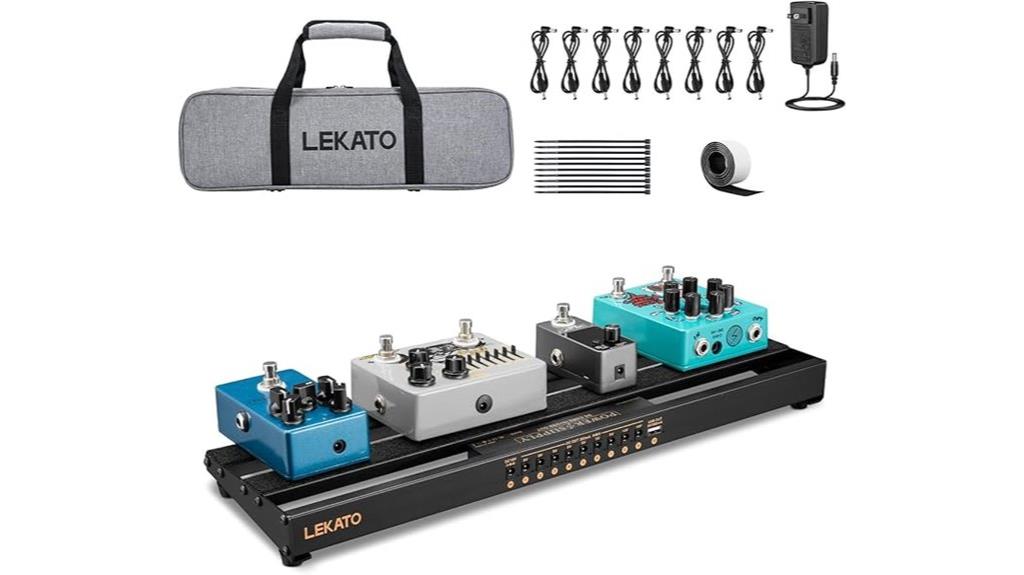
Since budget-conscious guitarists often struggle with the dual expense of purchasing both a quality pedalboard and reliable power supply separately, the LEKATO Guitar Pedal Board presents an all-in-one solution that’s earned impressive 4.6-star ratings from over 160 users. You’ll get nine independent power ports including 7×9V, 1×12V, 1×18V, plus a USB port for phone charging, all housed within a lightweight aluminum alloy frame measuring 19×5.1×1.8 inches. The angled design prevents accidental pedal stepping while maximizing comfort, though some users report noise issues with the internal power supply and find the pre-attached velcro inconvenient for customization.
Best For: Budget-conscious guitarists who want an affordable all-in-one solution combining a lightweight pedalboard with built-in power supply featuring multiple voltage options.
Pros:
- All-in-one design eliminates the need to purchase separate pedalboard and power supply, saving money and setup time
- Nine independent power ports with multiple voltage options (9V, 12V, 18V, USB) plus individual short-circuit protection for each channel
- Lightweight aluminum alloy construction with angled design for comfortable pedal access and includes high-quality carrying bag
Cons:
- Some users experience noise issues with the internal power supply affecting audio quality
- Pre-attached velcro limits customization options and flexibility for pedal placement
- Additional patch cables not included, requiring separate purchase for optimal connectivity
Guitar Pedal Board with Built-in Power Supply (RPB-150)

Ten independent power outputs distinguish the RPB-150 as the ideal choice for guitarists who’ve grown tired of managing multiple wall adapters, daisy chains, and the inevitable ground loop hum that accompanies most makeshift pedalboard setups. You’ll appreciate the aluminum alloy construction‘s rust resistance, though at 3.64 pounds, it’s surprisingly lightweight for such robust materials. The golden-angle design accommodates comfortable stepping, while hook and loop tapes secure your pedals without permanent modifications. Short-circuit protection isolates each output, preventing cascade failures that typically plague inferior power systems, and 12V plus USB-A outputs handle demanding digital pedals effortlessly.
Best For: Guitarists who use multiple pedals and want to eliminate the hassle of managing separate power adapters while avoiding ground loop hum and power-related issues.
Pros:
- Ten independent power outputs with short-circuit protection prevent one faulty pedal from affecting others
- Lightweight aluminum alloy construction (3.64 lbs) with rust resistance and comfortable golden-angle design for stepping
- Includes comprehensive accessories like padded carrying bag, pedal cables, and zip ties for complete setup
Cons:
- Power cables are not right-angle design, making them more exposed to potential damage during use
- Limited to smaller pedalboard size at 19.09×5.11 inches, which may not accommodate larger pedal collections
- Relatively new product (available since December 2024) with limited long-term reliability data from users
DAddario XPND Pedalboard – Small
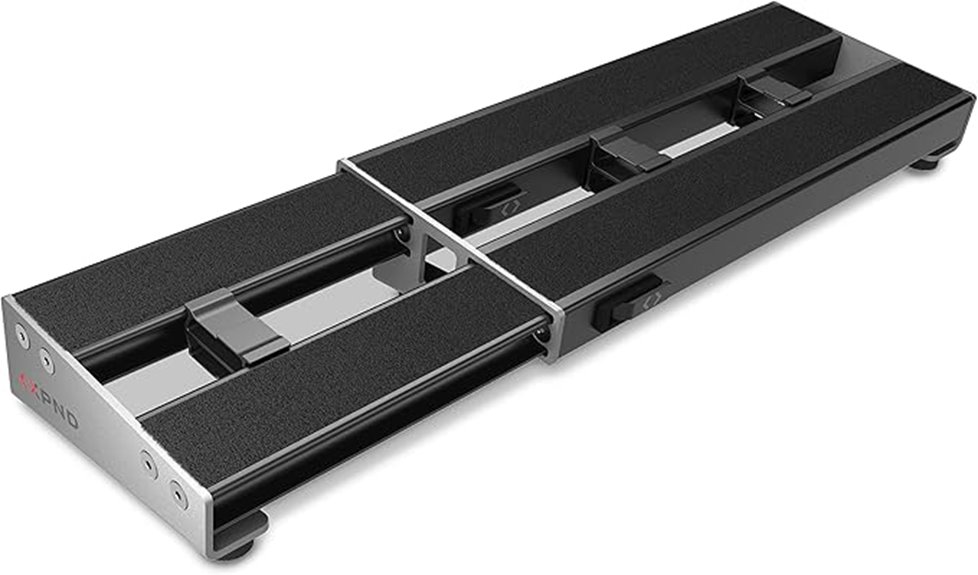
The DAddario XPND Pedalboard – Small stands out as the ideal solution for guitarists who need flexibility without sacrificing portability, thanks to its patented telescoping design that expands from 14 to 24 inches depending on your gig requirements. Weighing just one pound, this aluminum board features pre-applied loop Velcro and an innovative cable management system that prevents the tangling chaos I’ve experienced with other boards. The 20-30 minute assembly feels straightforward, though you’ll find limited space underneath for power supplies. With 4.7 out of 5 stars from 631 customers, it delivers reliable performance across venues, making setup customization remarkably efficient for touring musicians.
Best For: Touring guitarists and musicians who need a lightweight, expandable pedalboard that can adapt to different venue sizes and gig requirements while maintaining excellent portability.
Pros:
- Patented telescoping design expands from 14-24 inches for maximum flexibility while weighing only 1 pound
- Innovative cable management system and pre-applied loop Velcro prevent tangling and enable easy pedal swapping
- Highly durable aluminum construction with 4.7/5 star rating from 631 customers, proven to withstand heavy touring use
Cons:
- Limited space underneath the board for accommodating power supplies
- Requires 20-30 minutes of assembly time upon initial setup
- Transport bag must be purchased separately as an additional expense
Ghost Fire Guitar Pedal Board Aluminum Alloy Effect Pedalboard (SPL-01)
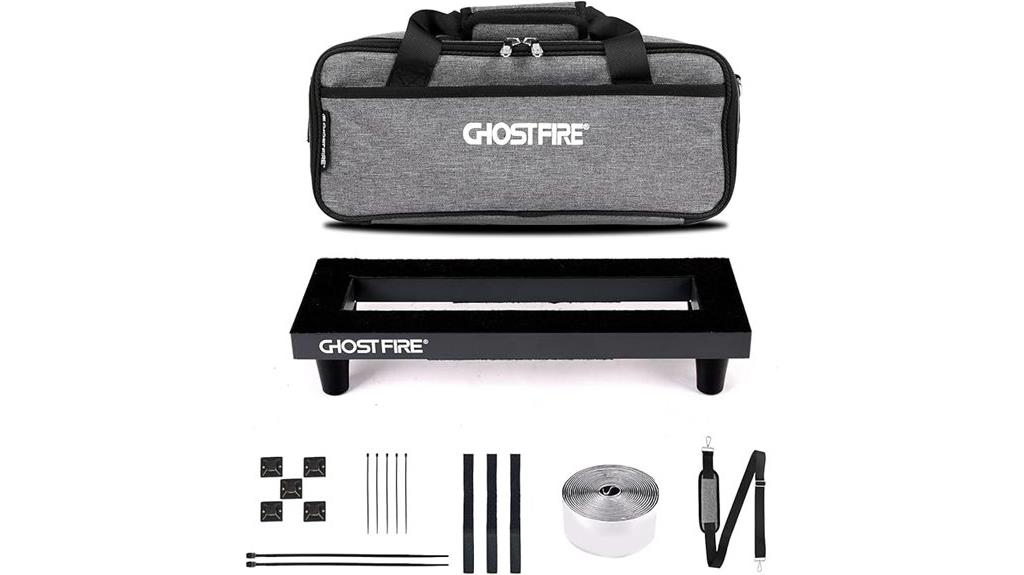
Compact pedalboards face a persistent challenge in balancing portability with durability, and I’ve found that the Ghost Fire Guitar Pedal Board Aluminum Alloy Effect Pedalboard (SPL-01) addresses this concern through its 5052 ultra-hard aluminum alloy construction that weighs just 0.8 pounds while maintaining professional-grade reliability. You’ll appreciate the patented foot stand design that tilts the 13.7 x 5.5-inch surface for easier access during performances, then folds flat for storage. The precision-cut aluminum features sandblasted surfaces with ABS corner protection, while pre-attached 3.8cm loop tape and customizable hook strips secure your 3-4 effects pedals efficiently. The included storage bag converts between handbag and shoulder configurations.
Best For: Guitarists who need a lightweight, portable pedalboard for small to medium setups (3-4 pedals) and value easy transport with professional durability for live performances or studio sessions.
Pros:
- Ultra-lightweight at 0.8 pounds with durable 5052 aluminum alloy construction that withstands professional use
- Patented tilting foot stand design improves pedal accessibility during performances and folds completely flat for storage
- Comprehensive storage solution with versatile carrying bag that functions as handbag, shoulder bag, or attaches to luggage
Cons:
- Limited capacity of only 3-4 pedals may be insufficient for guitarists with larger effect collections
- Compact 13.7 x 5.5-inch dimensions may not accommodate larger boutique or vintage effects pedals
- Aluminum construction may be more expensive than plastic alternatives for budget-conscious musicians
LEKATO Guitar Pedal Board with Carry Bag and Mounting Tape
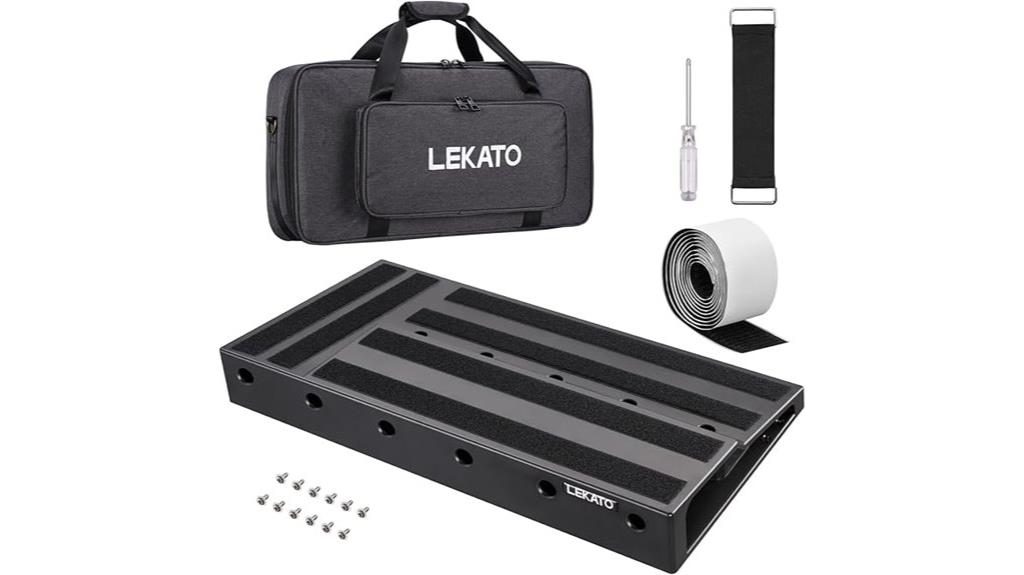
LEKATO’s Guitar Pedal Board stands out as an exceptional choice for guitarists who need versatile organization without sacrificing portability, combining a spacious 22x11x2.8 inch platform with thoughtful design elements that address common pedalboard frustrations. The built-in power supply compartment keeps things remarkably tidy, accommodating standard supplies including vxxdxx lab or brick units, while the angled design gives you straightforward pedal access that I’ve found genuinely useful during performances. You’ll appreciate the double-layer configuration that maximizes space efficiency, plus designated areas for expression or wah pedals that actually work as advertised. The heavy-duty carrying bag includes practical touches like shoulder straps and a front cable pocket.
Best For: Guitarists who need a versatile, well-organized pedalboard solution that balances ample space for multiple pedals with convenient portability for performances and travel.
Pros:
- Built-in power supply compartment and angled design keep cables organized and provide easy pedal access during performances
- Double-layer configuration and designated spaces for expression/wah pedals maximize space efficiency and accommodate various pedal sizes
- Heavy-duty carrying bag with shoulder straps and cable pocket makes transportation convenient and protects equipment
Cons:
- At 22x11x2.8 inches, the board may be too large for guitarists who only use a few pedals or have limited stage space
- Assembly required with included screwdriver, which adds setup time compared to ready-to-use alternatives
- The fixed layout with designated pedal areas may not suit guitarists who prefer completely customizable pedal arrangements
Factors to Consider When Choosing a Pedalboard for Guitar
When I’m helping guitarists select their ideal pedalboard, I’ve found that five critical factors consistently determine whether they’ll love their setup or regret their purchase within months. The size and pedal capacity must align with your current collection and future expansion plans, while power supply compatibility, build material durability, and overall portability directly impact your gigging experience and long-term satisfaction. I’ll walk you through each consideration systematically, because understanding these elements upfront saves you from costly mistakes and guarantees your pedalboard grows with your musical journey rather than limiting it.
Size and Pedal Capacity
The vast array of available pedalboard dimensions can feel overwhelming at first, but I’ve found that understanding the relationship between board size and pedal capacity makes the selection process considerably more straightforward. Common dimensions like 14 x 10.6 inches typically accommodate 4-8 pedals, which works perfectly for most guitarists who aren’t running elaborate multi-effect chains. If you’re building more complex setups, larger boards measuring 22 x 12.5 inches provide the real estate needed for extensive pedal collections. I always recommend counting your current pedals, then adding two or three spaces for future acquisitions because, let’s face it, we all inevitably expand our collections. The key is balancing your actual needs with realistic growth expectations.
Power Supply Options
After years of dealing with noisy power supplies and tangled cable messes, I can confidently say that built-in power options represent one of the most significant advances in modern pedalboard design. Today’s integrated systems deliver clean, noise-free power through multiple independent outputs, typically featuring 9V, 12V, and 18V configurations to accommodate various pedal requirements. I’ve found that short-circuit protection on each channel prevents one faulty connection from compromising your entire setup, which has saved me from countless frustrating gig interruptions. The hidden power compartments keep everything organized while eliminating cable chaos beneath your board. When selecting a pedalboard, I always consider the total output count and current ratings, ensuring compatibility with high-draw pedals like digital delays and reverbs.
Material and Durability
Durability separates the pedalboards that’ll survive years of abuse from those destined for the repair shop, and I’ve learned this lesson through enough broken gear to stock a small music store. Aluminum alloy construction stands out as the sweet spot, offering lightweight portability without sacrificing strength, while preventing the warping that plagues cheaper materials. Premium finishes resist rust and scratches, maintaining their appearance even after countless gigs in questionable venues. Design elements like ergonomic inclines and rubber feet enhance stability, preventing bending during enthusiastic performances. Some models handle up to 1500 pounds of tensile strength, which means your pedalboard won’t buckle under pressure, literally or figuratively, ensuring reliable performance from practice sessions to stadium shows.
Portability and Weight
Two critical factors determine whether you’ll actually want to carry your pedalboard to gigs: weight and overall portability, and I’ve made enough regrettable choices hauling overly heavy rigs to appreciate the difference. I recommend targeting pedalboards weighing between 1 to 3 pounds, which notably reduces fatigue during transport without sacrificing functionality. Compact dimensions measuring 14 to 24 inches provide excellent portability while fitting standard carrying cases, and I’ve found aluminum alloy construction offers the best weight-to-durability ratio. Features like integrated carrying bags, built-in handles, collapsible designs, and compartments for power supplies streamline the transportation process considerably. These seemingly minor conveniences become major advantages when you’re loading gear after a long performance.
Cable Management Features
Beyond the physical burden of transport, smart cable management transforms your pedalboard from a chaotic tangle of wires into a professional, reliable setup that I’ve learned to appreciate through countless frustrating moments spent untangling interconnects mid-performance. I prioritize boards featuring integrated routing channels, zippered pouches for spare cables, and pre-applied Velcro strips that secure connections without requiring additional hardware purchases. These features prevent accidental disconnections during critical moments, maintaining signal integrity while creating cleaner aesthetics that impress venue sound engineers. Quality cable management systems also facilitate quicker setup changes between songs, allowing me to swap pedals efficiently without creating wire spaghetti underneath my board that inevitably leads to signal loss or embarrassing technical difficulties.
Budget and Value
Setting a realistic budget becomes the foundation of any successful pedalboard purchase, though I’ve witnessed countless guitarists convince themselves they need premium features they’ll never actually use, ultimately spending double their original target while neglecting pedals that would enhance their sound more markedly. I recommend starting with boards between $75-$125, which typically include built-in power supplies, lightweight construction, and essential accessories that eliminate additional costs. Higher-end options around $150-$200 offer premium materials and extended warranties, potentially saving replacement expenses over years of regular use. I’ve learned that customer reviews reveal whether expensive boards truly justify their pricing through reliability and performance, while reputable brands maintain better resale value when you’re ready to upgrade your setup.
On a final note
Finding the right pedalboard comes down to your specific needs, budget, and playing style. I’ve tested countless boards over the years, and honestly, there’s no universal winner. Whether you prioritize built-in power supplies, premium materials, or simple portability, each option here offers solid value. Consider your pedal collection size, gigging requirements, and long-term expansion plans before deciding. Your perfect pedalboard will transform your setup’s organization.

